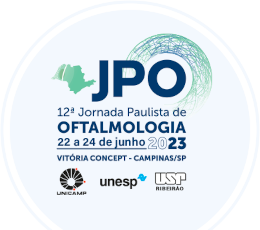Dados do Trabalho
Título
SUBRETINAL METALLIC FOREIGN BODY REMOVAL: ELECTRORETINOGRAPHIC REPERCUSSIONS GUIDING SURGICAL DECISION
Resumo
Introduction
Eye trauma is considered one of the main causes of blindness in the world. When associated with ocular perforation and intraocular foreign body (IOFB) it is a dramatic situation, that account for 18 to 41% of cases of open globe injury, with 60 to 88% of IOFB located in the posterior segment. Most episodes occur in young male patients due to occupational activity. Clinical presentation and visual damage vary according to IOFB size, location, mechanism of trauma, and type of material. Its immediate detection and treatment are essential to reduce morbidity.
Purpose
To describe the surgical decision in a case of intraocular foreign body (IOFB) based on imaging and electrophysiological examinations
Methods
Review of the patient’s medical record
Results
A young man reported visual escotoma in the left eye after trauma with a unknown object while working as Carpenter 1 day ago. On ophthalmologic examination the visual acuity was 20/20 in both eyes. Biomicroscopy of OS presented an laceration of the conjunctiva and sclera measuring 1 mm in diameter near the caruncula, without alterations in the anterior chamber. OS fundus showed an elevated region in the inferior nasal retina. OCT revealed a subretinal hyperreflective lesion in the previously described topography, suggestive of a IOFB. As the patient had excellent visual acuity, and the nature of IOFB was uncertain, it was decided to perform an electroretinography exam to assess possible retinal toxicity by IOFB over a period of 7 days. Evaluating the responses of the OS to stimuli, and comparing with the right eye response, we noticed a decrease of response amplitude over the seven days. The unequivocal data of retinal toxicity made IOFB removal mandatory. Thus, posterior vitrectomy via pars plana and removal of IOFB was performed. One month after surgery, the patient presented visual acuity of 20/40 in the left eye, disorganization of the retinal layers in the topography of the foreign body, but with a preserved macular region
Conclusion
The report showed how ERG findings guided the decision for surgical treatment once the nature of the IOFB was unknown. The presence of reduced oscillatory potentials, in addition to a reduced amplitude of a,b-wave after day 7, brought unequivocal data of retinal toxicity by IOFB, probably consisting of iron or copper.
The seven-day delayed removal of the intraocular foreign body is supported by the literature. The visual outcome is similar in cases operated immediately or within the first 14 days. However, its removal cannot be postponed beyond this period, under the risk of retinal detachment and irreversible retinal toxicity.
The prognosis of an IOFB depends on multiple factors, such as time of presentation, visual acuity presented, lesion extension, foreign body location, and associated factors (endophthalmitis, retinal detachment, vitreous hemorrhage). Fortunately, our patient did not have several bad prognostic factors, and he recovered satisfactorily, with visual acuity of 20/40 one month after surgery. The patient will continue in regular clinical follow-up, with a new electroretinogram exam as soon as possible, since there are reports in the literature of small iron particles retained in the retina after surgery, perpetuating the lesion and changes in the ERG even after 3 years.
Palavras Chave
intraocular foreign body; vitrectomy; siderosis; chalcosis.
Área
Retina
Autores
MOISES MOURA DE LUCENA, JULINA VIEIRA, RENATO BREDARIOL PEREIRA, JOÃO PEDRO ROMERO BRAGA, ISABELA FRANCO VILLELA, RENATA MORETO, RODRIGO JORGE, FRANCYNE VEIGA REIS
